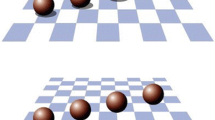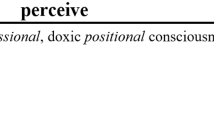Abstract
Two interrelated series of experiments are critically reviewed: experiments concerned with the objective validity of hypnotic visual and auditory hallucinations; and experiments which set out to specify the variables relevant to eliciting such hallucinations. The first series of experiments failed to demonstrate that hypnotic hallucinations produce objective effects which are the same as the effects produced by visual or auditory stimulation or different from the effects produced by imagining. Experiments in the second category indicate that the so-called “trance state” may be an extraneous variable in eliciting testimony from experimental Ss that suggested objects were seen and suggested sounds were heard. The relevant variables appear to include: (1) direct suggestions to see (nonexistent) objects and to hear (nonexistent) sounds, that are (2) given firmly and seriously to Ss who are motivated to perform to the best of their ability on assigned experimental tasks.
Similar content being viewed by others
References
BARBER, T. X. The afterimages of “hallucinated” and “imagined” colors. J. abnorm. soc. Psychol., 1959, 59, 136–139. (a)
BARBER, T. X. The “eidetic image” and “hallucinatory” behavior: A suggestion for further research. Psychol. Bull., 1959, 56, 236–239. (b)
BARBER, T. X. Antisocial and criminal acts induced by “hypnosis”: A review of experimental and clinical findings. Arch. gen. Psychiat., 1961, 5, 301– 312. (a)
BARBER, T. X. Experimental evidence for a theory of hypnotic behavior: II. Experimental controls in hypnotic age-regression. Int. J. clin. exp. Hypnosis, 1961, 9, 181–193. (b)
BARBER, T. X. Physiological effects of “hypnosis.” Psychol. Bull., 1961, 58, 390–419. (c)
BARBER, T. X. Experimental controls and the phenomena of “hypnosis”: A critique of hypnotic research methodology. J. nerv. ment. Dis., 1962, 134, 493–505. (a)
BARBER, T. X. Hypnotic age regression: A critical review. Psychosom. Med., 1962, 24, 286–299. (b)
BARBER, T. X. Toward a theory of hypnosis: Posthypnotic behavior. Arch. gen. Psychiat., 1962, 7, 321–342. (c)
BARBER, T. X. Toward a theory of “hypnotic” behavior: The “hypnotically induced dream.” J. nerv. ment. Dis., 1962, 135, 206–221. (d)
BARBER, T. X. The effects of “hypnosis” on pain: A critical review of experimental and clinical findings. Psychosom. Med., 1963, 25, 303–333.
BARBER, T. X. Hypnotizability, suggestibility, and personality: V. A critical review of research findings. Psychol. Rep., 1964, 14, 299–320.
BARBER, T. X., & CALVERLEY, D. S. “Hypnotic behavior” as a function of task motivation. J. Psychol., 1962, 54, 363–389.
BARBER, T. X., & CALVERLEY, D. S. “Hypnotic-like” suggestibility in children and adults. J. abnorm. soc. Psychol., 1963, 66, 589–597. (a)
BARBER, T. X., & CALVERLEY, D. S. The relative effectiveness of task-motivating instructions and trance-inductions procedure in the production of “hypnoticlike” behaviors. J. nerv. ment. Dis., 1963, 137, 107–116. (b)
BARBER, T. X., & CALVERLEY, D. S. Toward a theory of hypnotic behavior: Effects on suggestibility of task motivating instructions and attitudes toward hypnosis. J. abnorm. soc. Psychol., 1963, 67, 557–565. (c)
BARBER, T. X., & CALVERLEY, D. S. An experimental study of “hypnotic” (auditory and visual) hallucinations. J. abnorm. soc. Psychol., 1964, 68, 13–20. (a)
BARBER, T. X., & CALVERLEY, D. S. Toward a theory of “hypnotic” behavior: “Hypnotic time distortion.” Arch. gen. Psychiat., 1964, 10, 209–216. (b)
BARBER, T. X., & DEELEY, D. C. Experimental evidence for a theory of hypnotic behavior: I. “Hypnotic color-blindness” without “hypnosis.” Int. J. clin. exp. Hypnosis, 1961, 9, 79–86.
BARBER, T. X., & HAHN, K. W., JR. Physiological and subjective responses to pain producing stimulation under hypnotically-suggested and waking-imagined “analgesia.” J. abnorm. soc. Psychol., 1962, 65, 411–418.
BARBER, T. X., & HAHN, K. W., JR. Hypnotic induction and “relaxation”: An experimental study. Arch. gen. Psychiat., 1963, 8, 295–300.
BERNHEIM, H. Suggestive therapeutics. Westport, Conn.: Associated Booksellers, 1957. (Originally published in 1888)
BINET, A., & FÉRÉ, C. Animal magnetism. New York: D. Appleton & Co., 1888.
DOBIE, SHIRLEY. Operant conditioning of verbal and hallucinatory responses with nonverbal reinforcement. Paper read at Midwest Psychol. Ass., Chicago, May, 1959.
DORCUS, R. M. Modification by suggestion of some vestibular and visual responses. Amer. J. Psychol., 1937, 49, 82–87.
DOWNEY, JUNE E. An experiment on getting an after-image from a mental image. Psychol. Rev., 1901, 8, 42–55.
ELSEA, O. C., JR. A study of the effect of hypnotic suggestion on color perception. Doctoral dissertation, Univer. of Oklahoma, 1961.
ERICKSON, M. H. Deep hypnosis and its induction. In L. M. LeCron (Ed.), Experimental hypnosis. New York: Macmillan, 1958. Pp. 70–112.
ERICKSON, M. H., & ERICKSON, ELIZABETH M. The hypnotic induction of hallucinatory color vision followed by pseudo negative after-images. J. exp. Psychol., 1938, 22, 581–588.
ERICKSON, M. H., HERSHMAN, S., & SECTER, I. I. The practical application of medical and dental hypnosis. New York: Julian Press, 1961.
FAW, V., & WILCOX, W. W. Personality characteristics of susceptible and unsusceptible hypnotic subjects. J. clin. exp. Hypnosis, 1958, 6, 83–94.
FISHER, S. Problems of interpretation and controls in hypnotic research. In G. H. Estabrooks (Ed.), Hypnosis: Current problems. New York: Harper & Row, 1962. Pp. 109–126.
GALTON, F. Inquiries into human faculty. New York: Macmillan, 1883.
GILL, M. M., & BRENMAN, MARGARET. Hypnosis and related states. New York: International Universities Press, 1959.
GOLDIAMOND, I., & MALPASS, L. F. Locus of hypnotically induced changes in color vision responses. J. opt. Soc. Amer., 1961, 51, 1117–1121.
HALPERN, S. On the similarity between hypnotic and mescaline hallucinations. Int. J. clin. exp. Hypnosis, 1961, 9, 139–149.
HIBLER, F. W. An experimental study of positive visual hallucinations in hypnosis. Doctoral dissertation, Ohio State Univer., 1935.
HIBLER, F. W. An experimental investigation of negative after-images of hallucinated colors in hypnosis. J. exp. Psychol., 1940, 27, 45–57.
HULL, C. L. Hypnosis and suggestibility: An experimental approach. New York: Appleton-Century-Crofts, 1933.
JAENSCH, E. R. Eidetic imagery. London: Kegan Paul, Trench, & Trubner, 1930.
LUNDHOLM, H. A hormic theory of hallucinations. Brit. J. med. Psychol., 1932, 11, 269–282.
MARTIN, LILLIEN J. Ghosts and the projection of visual images. Amer. J. Psychol., 1915, 26, 251–257.
MURPHY, D. B., & MYERS, T. I. Occurrence, measurement, and experimental manipulation of visual “hallucinations.” Percep. mot. Skills, 1962, 15, 47–54.
NARUSE, G. Hypnosis as a state of meditative concentration and its relationship to the perceptual process. In M. V. Kline (Ed.), The nature of hypnosis. New York: Institute for Research in Hypnosis, 1962. Pp. 37–55.
ORNE, M. T. Hypnotically induced hallucinations. In L. J. West (Ed.), Hallucinations. New York: Grune & Stratton, 1962. Pp. 211–219.
PARKER, P. D., & BARBER, T. X. “Hypnosis,” task-motivating instructions, and learning performance. J. abnorm. soc. Psychol., in press.
PATTIE, F. A. Methods of induction, susceptibility of subjects, and criteria of hypnosis. In R. M. Dorcus (Ed.), Hypnosis and its therapeutic applications. New York: McGraw-Hill, 1956. Chap. 2.
PURDY, D. M. Eidetic imagery and plasticity of perception. J. gen. Psychol., 1936, 15, 437–454.
ROSENTHAL, B. G., & MELE, H. The validity of hypnotically induced color hallucinations. J. abnorm. soc. Psychol., 1952, 47, 700–704.
ROSSI, A. M., STURROCK, J. B., & SOLOMON, P. Suggested effects on reported imagery in sensory deprivation. Percept. mot. Skills, 1963, 16, 39–45.
SARBIN, T. R. Contributions to role-taking theory: I. Hypnotic behavior. Psychol. Rev., 1950, 57, 255–270.
SARBIN, T. R., & ANDERSEN, M. L. Base-rate expectancies and perceptual alterations in hypnosis. Brit. J. soc. clin. Psychol., 1963, 2, 112–121.
SCHNECK, J. M. An experimental study of hypnotically induced auditory hallucinations. J. clin. exp. Hypnosis, 1954, 2, 163–170.
SIDIS, B. Are there hypnotic hallucinations? Psychol. Rev., 1906, 13, 239–257.
SUTCLIFFE, J. P. “Credulous” and “sceptical” views of hypnotic phenomena: A review of certain evidence and methodology. Int. J. clin. exp. Hypnosis, 1960, 8, 73–101.
SUTCLIFFE, J. P. “Credulous” and “skeptical” views of hypnotic phenomena: Experiments in esthesia, hallucinations, and delusion. J. abnorm. soc. Psychol., 1961, 62, 189–200.
UNDERWOOD, H. W. The validity of hypnotically induced visual hallucinations. J. abnorm. soc. Psychol., 1960, 61, 39–46.
WEITZENHOFFER, A. M. General techniques of hypnotism. New York: Grune & Stratton, 1957.
WEITZENHOFFER, A. M. The nature of hypnosis. Amer. J. clin. Hypnosis, 1963, 5, 295–321, 6, 40–72.
WEITZENHOFFER, A. M., & HILGARD, E. R. Stanford hypnotic susceptibility scale: Form C. Palo Alto: Consulting Psychologists Press, 1962.
WHITE, R. W. An analysis of motivation in hypnosis. J. gen. Psychol., 1941, 24, 145–162. (a)
WHITE, R. W. A preface to the theory of hypnotism. J. abnorm. soc. Psychol., 1941, 36, 477–505. (b)
Author information
Authors and Affiliations
Additional information
The writing of this paper was made possible by grants (MY-04825 and MH-07003) from the National Institute of Mental Health, United States Public Health Service.
Rights and permissions
About this article
Cite this article
Barber, T.X. Toward a theory of “hypnotic” behavior: Positive visual and auditory hallucinations. Psychol Rec 14, 197–210 (1964). https://doi.org/10.1007/BF03393578
Published:
Issue Date:
DOI: https://doi.org/10.1007/BF03393578




